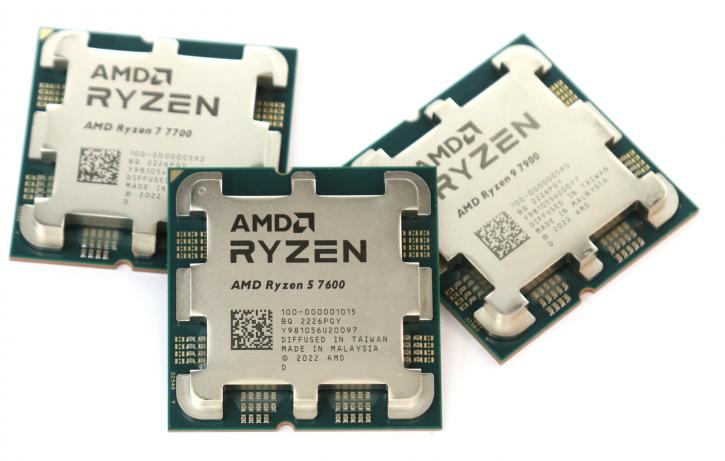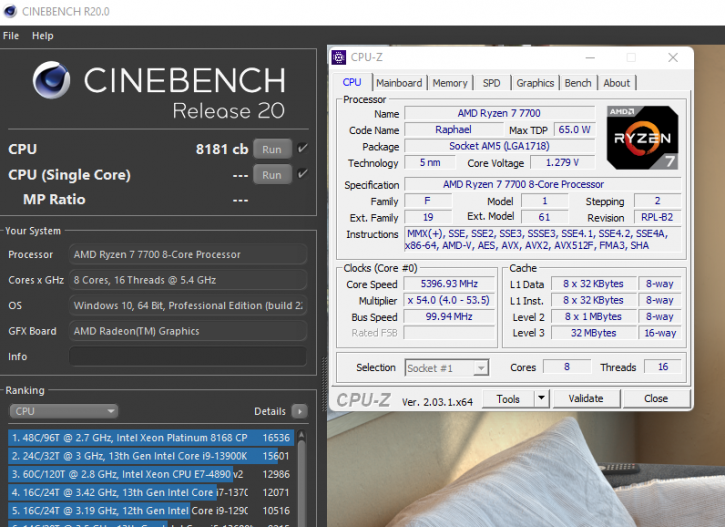Conclusion
Final Words
The picture that the non-X 7700 paints is a very potent one. Yeah we're liking the new non-X 7700, it needs far less cooling as under load, it sits at 70 Degrees C with relatively simple all-in-one liquid cooling. Next to that with a far more impressive rated 65W TDP it is only a few per cent away from the 7700X, and the processor is unlocked, how's that not a win, really? The processor offers plenty of performance for an 8-core part, and you reap the benefits in gaming as well with the more premium graphics card that are sometimes CPU bound (bottlenecked). In general speaking, AMD couldn't launch 65W processors anytime sooner, as the heat of the flagship model X SKU's haunting the sales, well that and the total cost of ownership, including DDR5 and a new motherboard. The Ryzen 7 7700 features eight cores and can be purchased for $329, offering roughly 5% less performance than its X counterpart, and that's a very reasonable proposition. Its lower operating temperatures are a big plus, and 8 cores are ideal for gaming. It has PCI Express Gen 5, Dual Channel DDR5, and a CPU that can reach 5.3 GHz with ease; therefore, it has the potential to become AMD's sweet spot processor if you can find cheap motherboards to go along with it.
Price and value
The price premium for Series 7000 processors is a little despicable when you look at the total cost of ownership; it differentiates and, I suppose, is not cannibalising the current Ryzen 5000 series. We expect the 7700 to retail for $329, and if it is more expensive, we ask that you hold off on buying it until the price has stabilised due to high demand. What retailers dare to ask these days is incredible. You will spend roughly $41 USD per core for this Ryzen 7000 processor. Factor in the cost of ownership for the complete ecosystem, as well as DDR5 and a new AM5 motherboard, of course. Because of its price level, I am not a fan of X670(E) motherboards. I strongly advise you to pursue a B650 series motherboard have to offer, as the difference will be primarily USB/SATA related, that and WIFI6e. Unless you require dozens of USB connections and PCIe gen 5.0 GPU slots, the infrastructure provided by these boards remains excellent.
Gaming performance
The new architecture and high clock rates assist AMD in regaining ground on Intel's 12th Gen devices, but Intel is poised to win with 13th Gen processors. However, both had some wins and losses (in comparison to 12th Gen Alder Lake). Individual wins per brand and processor segmentation (mainstream, high-end, and enthusiast) are now exact. So, on average, this processor can feed frames as quickly as Intel's equivalent with a powerful graphics card. However, your gaming experience will be excellent at six or eight cores; we believe that eight cores are the norm these days for a truly fantastic gaming PC and overall PC desktop.
DDR5 Memory
While DDR5 memory is already becoming more affordable, you will most certainly pay a premium right now. AMD indicates that 6000 MHz is a sweet spot, however, please read our memory scaling article, as 5200 MHz gets you there 99% of the time as well. We test with two 16GB G.Skill memory modules rated 6000:CL30. With this frequency and latency, the sweet spot will never be pricing. We had no stability difficulties, but since AMD provided these kits, they have been thoroughly tested for compatibility. This is not a complaint; with the introduction of a new architecture, Intel and AMD are always racing against the clock to ensure memory kits are firmware compatible. First-time PC post delay - The first time you'll start up your system, it'll trains memory. Once you set your XMP/EXPO profile, it'll do that again. This process can take 2-3 minutes. Once your memory is trained, POST and, thus, boot times will ramp up as fast as you usually can expect. So don't worry about that.
Energy efficiency and heat
The Ryzen 7 7700X is rated at 105 Watts, and the 7700 is a 65 Watts part. The thing is, much like Intel's PL2 states, AMD now applies a PPT of 142 W for the X model and an 88W PPT for the 7700 as tested, so that means your processor can utilize that wattage. All these factors produce all that heat we've been talking about. Our processor hovers in the ~70 Degrees C domain with a mainstream LCS cooler; we're fine with that.
Overclocking
As with all processors, you still have a bit of leech to overlock. With proper liquid cooling (an LCS kit with enough capacity), selecting all cores towards your maximum multiplier is the easiest way to overclock. With these temps at hand, we advise the voltage regulated by the motherboard (auto voltage). For Ryzen 7 7700, all-core max seems to be in the ~5400 MHz area with LCS; again, that's all cores.
Conclusion
Compared to the X series, I prefer the 65W processor's low power requirements and thermal output better (by far). We have not seen a better thoroughbred 8-core processor than this one for a while. It behaves extremely well; even with the most advanced and high-end graphics cards, it will perform adequately. This one's thermals and energy levels are also rather good, so everything is in order. However, installing a 7700/7700X on an X670(E) motherboard would be overkill. Please do opt for a B650 with lower overall platform costs. AMD performs well in terms of performance; compared to the 7600C you can see an average reduction of 10% performance at far better energy- and heat levels with clock frequencies reaching 5.1 GHz on some cores. That IPC forced AMD to unlock all available registers in exchange for improved thermal and energy efficiency. In addition to the new AM5 platforms, PCIe Gen 5 is now available. However, it serves no function at the moment because no graphics card requires PCIe Gen 5. We also anticipated that AMD would have seeded some Gen5-ready NVMe SSD samples. However, they have not yet been seeded or are even available. To be clear, we are not convinced that the PCIe Gen 5 SSD will make a major difference in real-world performance and user experience; yes, sustained rates will reach +10GB/s, but you will still get the same 4K read/write performance because the most important thing going on is bandwidth. In conclusion, we are impressed by AMD's new level of performance; Zen 4 is a step forward in performance, the entire cost of ownership (of the platform) for consumers is substantial though. It is perhaps worth noting that we had no stability concerns or other issues, which is great for a new platform. The 8-core Ryzen 7 7700 is is far more attractive at its price of 329USD and it's even unlocked. This is among the most affordable Zen 4 option available and only has that 65W TDP (which really isn't hurting performance); combined with B650 this is where greater value will be realised, as the X670(E) is quite pricey. Of course, AMD provides an upgrade path with Socket AM5, but AM4 has seen its last wave of processors. AMD guarantees AM5 socket compatibility till at least 2025. So, perhaps begin with this less expensive processor and then upgrade to a new generation in a year or two.
In conclusion, we are impressed by the new level of performance this CPU offers; Zen 4 is unquestionably a significant improvement over previous generations. We like this 65W part far better than the 105W X model. And here's a thought, perhaps AMD made the wrong call at the initial launch, as what we observed today is exactly where the processor needs to be TDP/heat-wise with performance is just a few % less than that X model. We like it.
- Sign up to receive a notification when we publish a new article
- Or go back to Guru3D's front page.




